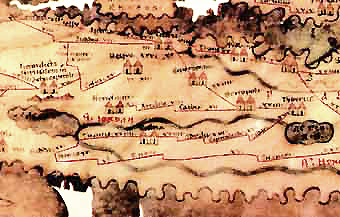Here reigned King Achab (Ahab), and here Helias prophesied (1 Kings 17,1ff). Here is the field in which David slew Goliath [Valley of Elah] (Ain Jalud ?) (1 Sam 17:49 – 51).
City of Scythopolis (Bethshean, Beisan) – 12 miles.
Aser (Teyasir), where was the house of Job – 6 miles.
City of Neapolis(Nablus) – 15 miles.
Here is the Mount Gerizim. Here the Samaritans say that Abraham offered sacrifice (Mount Moriah), and one reaches the top of the mountain by steps, three hundred in number. Beyond this, at the foot of the mountain itself, is a place called Sichem. Here is a tomb in which Joseph is laid, in the 'parcel of ground' (villa) which Jacob his father gave to him (Jos 24:32). From thence Dinah, the daughter of Jacob, was carried off by the children of the Amorites (Gen 34:2). A mile from thence is a place named Sichar, from which the woman of Samaria came down to the same place in which Jacob dug the well, to draw water from it, and our Lord Jesus Christ talked with her (John 4:5 – 30); in which place are plane – trees, which Jacob planted, and a bath (balneus – baptistry) which is supplied with water from the well.
Twenty – eight miles from thence on the left hand, as one goes towards Jerusalem, is a village (villa) named Bethar (Bethel, Beitin).
A mile from thence is the place where Jacob slept when he was journeying into Mesopotamia (Gen 28:11-12), and here is the almond tree; here Jacob saw the vision and the angel wrestled with him (Gen 32:24-33) . Here was King Jeroboam when the prophet was sent to him, that he should turn himself to the Most High God; and the prophet was ordered not to eat bread with the false prophet whom the king had with him, and because he was beguiled by the false prophet and ate bread with him, as he was returning a lion fell upon the prophet on the way and slew him (1Kings 1 - 34).
Thence to Jerusalem – 12 miles.
Total from Caesarea Palaestina to Jerusalem 116 miles, 4 halts, 4 changes.
Jerusalem
Thence to Jerusalem – 12 miles.
Total from Caesarea Palaestina to Jerusalem 116 miles, 4 halts, 4 changes.
There are in Jerusalem two large pools (piscinae) at the side of the temple (ad latus templi), that is, one upon the right hand, and one upon the left, which were made by Solomon; and further in the city are twin pools (piscinae gemellares),
with five porticoes, which are called Bethsaida (John 5:2-18). There persons who have been sick for many years are cured; the pools contain water which is red when it is disturbed. There is also here a crypt, in which Solomon used to torture devils.
Here is also the corner of an exceeding high tower , where our Lord ascended and the tempter said to Him, 'If thou be the Son of God, cast thyself down from hence.' (Matt 4:7). And the Lord answered, 'Thou shalt not tempt the Lord thy God, but him only shalt thou serve.' (Matt 4:10). There is a great corner – stone, of which it was said, 'The stone which the builders rejected is become the head of the corner.' (Matt 21:42; Ps 118:22). Under the pinnacle (pinna) of the tower are many rooms, and here was Solomon's palace. There also is the chamber in which he sate and wrote the (Book of) Wisdom; this chamber is covered with a single stone. There are also large subterranean reservoirs for water and pools constructed with great labour. And in the building (in aede) itself, where stood the temple which Solomon built, they say that the blood of Zacharias (Matt 23:35; Luke 11:51) which was shed upon the stone pavement before the altar remains to this day. There are also to be seen the marks of the nails in the shoes of the soldiers who slew him, throughout the whole enclosure, so plain that you would think they were impressed upon wax. There are two statues of Hadrian, and not far from the statues there is a perforated stone , to which the Jews come every year and anoint it, bewail themselves with groans, rend their garments, and so depart. There also is the house of Hezekiah King of Judah.
Also as you come out of Jerusalem to go up Mount Sion, on the left hand, below in the valley, beside the wall, is a pool which is called Siloe (John 9:7) and has four porticoes; and there is another large pool outside it. This spring runs for six days and nights, but on the seventh day, which is the Sabbath, it does not run at all, either by day or by night . On this side one goes up Sion, and sees where the house of Caiaphas the priest was, and there still stands a column against which Christ was beaten with rods. Within, however, inside the wall of Sion, is seen the place where was David's palace. Of seven synagogues which once were there, one alone remains; the rest are ploughed over and sown upon, as said Isaiah the prophet (Is 1:8; Michah 3:12).
From thence as you go out of the wall of Sion, as you walk towards the gate of Neapolis,
towards the right, below in the valley, are walls, where was the house or praetorium of Pontius Pilate (Matt 27:27). Here our Lord was tried before His passion. On the left hand is the little hill of Golgotha where the Lord was crucified (Matt 27:33). About a stone's throw from thence is a vault (crypta) wherein His body was laid, and rose again on the third day (Matt 27:63; 28:6). There, at present, by the command of the Emperor Constantine (iussu Constantini), has been built a basilica, that is to say, a church (dominicum) of wondrous beauty , having at the
side reservoirs (excepturia) from which water is raised, and a bath behind in which infants are washed (baptized).
Also as one goes from Jerusalem to the gate which is to the eastward, in order to ascend the Mount of Olives, is the valley called that of Josaphat. Towards the left, where are vineyards, is a stone at the place where Judas Iscariot betrayed Christ (Matt 26,47-50); on the right is a palm – tree, branches of which the children carried off and strewed in the way when Christ came (Matt 31:8). Not far from thence, about a stone's – throw, are two notable tombs of wondrous beauty; in the one, which is a true monolith, lies Isaiah the prophet, and in the other Hezekiah, King of the Jews.
From thence you ascend to the Mount of Olives, where before the Passion, the Lord
taught His disciples (Matt 24-25). There by the orders of Constantine a basilica of wondrous beauty has been built. Not far from thence is the little hill which the Lord ascended to pray, when he took Peter and John with Him, and Moses and Elias were beheld (Matt 17:1-8).
The Surroundings of Jerusalem:
Jericho and the Dead Sea
A mile and a half to the eastward is the village(villa) called Bethany. There is a vault (crypta) in which Lazarus, whom the Lord raised, was laid (John 11:1-44).
From Jerusalem to Jericho (Ariha) – 18 miles.
On the right hand side, as one descends from the mount, behind a tomb, is the sycamore tree into which Zacchaeus climbed that he might see Christ (Luke 19:4). A mile-and-a-half from the town is the fountain of Elisha. Formerly if any woman drank of it she did not bear children. Beside it lies an earthenware vessel. Elisha threw salt into it, and came and stood over the fountain and said, 'Thus saith the Lord, I have cleansed these waters, and if any woman drink of this fountain she shall bear children.' (2 Kings 2,19-22).
Above the same fountain is the house of the harlot Rahab, to whom the spies came, and she hid them, and alone was saved when Jericho was destroyed. Here stood the city of Jericho, round whose
walls the children of Israel circled with the Ark of the Covenant, and the walls fell down (Jos 2:1-21; 6:1-25). Nothing is to be seen of it except the place where the Ark of the Covenant stood, and the
twelve stones which the children of Israel brought out of Jordan (Jos 4:20-24). There Jesus, the son of Nave (Joshua the son of Nun), circumcised the children of Israel and buried their foreskins (Jos 5:2-9).
From Jericho (Ariha) to the Dead sea – 9 miles.
The water of it is very bitter, and in it there is no kind of fish whatever, nor any vessel; and if a man casts himself into it in order to swim, the water turns him over.
From thence to the Jordan, where the Lord was baptized by John (Matt 3:13 – 17) – 5 miles.
There is a place by the river, a little hill upon the further (left) bank, from which Elijah was caught up into heaven (2 Kings 2:1-13).
The Surroundings of Jerusalem:
Bethlehem and Hebron
From Jerusalem going to Bethlehem(Beit Lahm) – 6 miles.
On the road, on the right hand, is a tomb, in which lies Rachel, the wife of Jacob
(Gen 35:19-20; Matt 2:18). Two miles from thence, on the left hand, is Bethlehem, where our Lord Jesus Christ was born (Matt 2:1; Luke 2:1-7). A basilica has been built there by the orders of Constantine. Not far from thence is the tomb of Ezekiel, Asaph, Job, Jesse, David, and Solomon, whose names are inscribed in Hebrew letters upon the wall as you go down into the vault itself.
From thence to Bethasora (Bethzur, Beit Sur) – 14 miles.
There is the fountain in which Philip baptized the eunuch (Acts 8:26-39).
Thence to Terebinthus (Mamre, Ramet el – Khalil) – 8 miles.
Here Abraham dwelt, and dug a well under a terebinth tree, and spoke with angels, and ate food with them (Gen 18:1-15). Here a basilica of wondrous beauty has been built by the command of Constantine.
From Terebinthus (Ramet el – Khalil) to Hebron (el – Khalil) – 2 miles.
Here is a monument (memoria) of square form built of stone of wondrous beauty, in which lie Abraham, Isaac, Jacob, Sara, Rebecca, and Leah (Gen 23:1-20; 25:7-10).
From Jerusalem as follows:
City of Nicopolis (Amwas) – 22 miles.
City of Lydda (Ludd) – 10 miles.
Change at Antipatris (Ras el – Ain) – 10 miles.
Change at Betthar (Tireh) – 10 miles.
City of Caesarea (Kaisarieh) – 16 miles.
Total from Constantinople to Jerusalem 1,159 miles, 69 changes, 58 halts.
Also through Nicopolis (Amwas) to Caesarea (Kaisarieh)
73 miles, 5 changes, 3 halts.
English translation by Aubrey Stewart (Palestine Pilgrim's Text Society, 1887)

